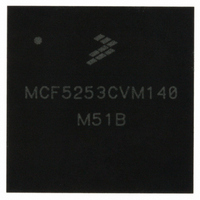MCF5253CVM140 Freescale Semiconductor, MCF5253CVM140 Datasheet - Page 231

MCF5253CVM140
Manufacturer Part Number
MCF5253CVM140
Description
IC MPU 32BIT 140MHZ 225-MAPBGA
Manufacturer
Freescale Semiconductor
Series
MCF525xr
Datasheets
1.MCF5253VM140J.pdf
(34 pages)
2.MCF5253VM140J.pdf
(8 pages)
3.MCF5253VM140J.pdf
(648 pages)
4.MCF5253VM140J.pdf
(2 pages)
Specifications of MCF5253CVM140
Core Processor
Coldfire V2
Core Size
32-Bit
Speed
140MHz
Connectivity
CAN, EBI/EMI, I²C, QSPI, UART/USART, USB OTG
Peripherals
DMA, WDT
Program Memory Type
ROMless
Ram Size
128K x 8
Voltage - Supply (vcc/vdd)
1.08 V ~ 1.32 V
Data Converters
A/D 6x12b
Oscillator Type
External
Operating Temperature
-40°C ~ 85°C
Package / Case
225-MAPBGA
Family Name
MCF5xxx
Device Core
ColdFire V2
Device Core Size
32b
Frequency (max)
140MHz
Instruction Set Architecture
RISC
Supply Voltage 1 (typ)
1.2/3.3V
Operating Supply Voltage (max)
1.32/3.6V
Operating Supply Voltage (min)
1.08/3V
Operating Temp Range
-40C to 85C
Operating Temperature Classification
Industrial
Mounting
Surface Mount
Pin Count
225
Package Type
MA-BGA
Lead Free Status / RoHS Status
Lead free / RoHS Compliant
Number Of I /o
-
Eeprom Size
-
Program Memory Size
-
Lead Free Status / Rohs Status
Compliant
Available stocks
Company
Part Number
Manufacturer
Quantity
Price
Company:
Part Number:
MCF5253CVM140
Manufacturer:
FREESCALE
Quantity:
300
Company:
Part Number:
MCF5253CVM140
Manufacturer:
Freescale Semiconductor
Quantity:
10 000
Part Number:
MCF5253CVM140
Manufacturer:
FREESCALE
Quantity:
20 000
Company:
Part Number:
MCF5253CVM140J
Manufacturer:
Freescale Semiconductor
Quantity:
10 000
- MCF5253VM140J PDF datasheet
- MCF5253VM140J PDF datasheet #2
- MCF5253VM140J PDF datasheet #3
- MCF5253VM140J PDF datasheet #4
- Current page: 231 of 648
- Download datasheet (8Mb)
14.3
The DMA controller module usually transfers data at rates much faster than the ColdFire core under
software control can handle. The term DMA refers to the ability for a peripheral device to access memory
in a system in the same manner as the core. DMA operations can greatly increase overall system
performance.
The DMA module consists of four independent channels. The term DMA is used throughout this section
to reference any of the four channels, as they are all functionally equivalent. It is impossible to implicitly
address all four DMA channels at the same time.
DMA requests can be generated by the processor writing to the START bit in the DMA control register or
generated by an on-chip peripheral device asserting one of the REQUEST signals. The processor can
program the amount of bus bandwidth allocated for the DMA for each channel. The DMA channels
support continuous and cycle-steal transfer modes.
The DMA controller supports dual-address transfers. In dual-address mode, the DMA channel supports 32
bits of address and 32 bits of data. Dual-address transfers can be initiated by either a processor request
using the START bit or by an internal peripheral device using the REQUEST signal. Two bus transfers
occur in this mode, a read from a source device and a write to a destination device (see
Any operation involving the DMA module follows the same three basic steps:
Freescale Semiconductor
1. Channel initialization step—The DMA channel registers are loaded with control information,
2. Data transfer step—The DMA accepts requests for operand transfers and provides addressing and
3. Channel termination step—This occurs after operation is complete. The channel indicates the
address pointers, and a byte transfer count. Also, the DMAROUTE register is programmed to
control the source of the internal requests.
bus control for the transfers.
status of the operation in the channel status register.
DMA Module Overview
DMA
Figure 14-2. Dual Address Transfer
MCF5253 Reference Manual, Rev. 1
PERIPHERAL
PERIPHERAL
MEMORY-
MEMORY-
MEMORY
MEMORY
MAPPED
MAPPED
or
or
Figure
DMA Controller
14-2).
14-3
Related parts for MCF5253CVM140
Image
Part Number
Description
Manufacturer
Datasheet
Request
R
Part Number:
Description:
Mcf5253 Coldfire? Microprocessor Data Sheet
Manufacturer:
Freescale Semiconductor, Inc
Datasheet:
Part Number:
Description:
Manufacturer:
Freescale Semiconductor, Inc
Datasheet:
Part Number:
Description:
Manufacturer:
Freescale Semiconductor, Inc
Datasheet:
Part Number:
Description:
Manufacturer:
Freescale Semiconductor, Inc
Datasheet:
Part Number:
Description:
Manufacturer:
Freescale Semiconductor, Inc
Datasheet:
Part Number:
Description:
Manufacturer:
Freescale Semiconductor, Inc
Datasheet:
Part Number:
Description:
Manufacturer:
Freescale Semiconductor, Inc
Datasheet:
Part Number:
Description:
Manufacturer:
Freescale Semiconductor, Inc
Datasheet:
Part Number:
Description:
Manufacturer:
Freescale Semiconductor, Inc
Datasheet:
Part Number:
Description:
Manufacturer:
Freescale Semiconductor, Inc
Datasheet:
Part Number:
Description:
Manufacturer:
Freescale Semiconductor, Inc
Datasheet:
Part Number:
Description:
Manufacturer:
Freescale Semiconductor, Inc
Datasheet:
Part Number:
Description:
Manufacturer:
Freescale Semiconductor, Inc
Datasheet:
Part Number:
Description:
Manufacturer:
Freescale Semiconductor, Inc
Datasheet:
Part Number:
Description:
Manufacturer:
Freescale Semiconductor, Inc
Datasheet:











